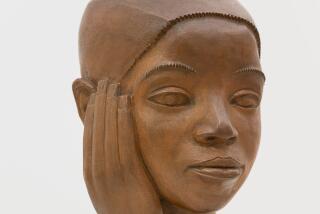Woman Seeks Justice for Grandma Beulah
- Share via
When Christine Johnson was a little girl, she learned that her grandmother was “crazy” and that a lobotomy had left her “childlike.” She pulled out her Barbies and offered them to Grandma Beulah.
“No, dear, I’m too old for that,” her grandmother said.
Now, more than two decades later, Johnson, 32, has pored over hundreds of pages of her grandmother’s medical and psychiatric files from her time as a patient at Pilgrim State Psychiatric Center in Brentwood, N.Y., from 1952 to 1972.
She has tried to understand why doctors performed the procedure, which involved drilling holes into the brain and swiping at the frontal lobes. It was thought to cure psychosis.
Johnson also is challenging the 1949 Nobel Prize awarded to Dr. Egas Moniz, who invented the procedure. Moniz died six years after winning the award.
At Pilgrim in 1952, Beulah Jones had 15 rounds of electroshock over 10 weeks, but her delusions continued. Doctors then recommended a form of lobotomy called a leukotomy.
Surgeons at Pilgrim drilled two holes above Jones’ hairline and plunged a leukotome 2 inches into the tissue in her frontal lobe. A sharp instrument with a loop cut through her frontal lobes. Her hallucinations persisted, but her emotional expressions grew dull, Johnson said.
In 1972, Jones’ grown daughter received a letter saying the hospital was releasing her mother. “They said she could be picked up,” Johnson said.
“I have never met anyone helped by a lobotomy,” said Johnson, a medical librarian who has created a website (www.psychosurgery.org) and continues to press the Nobel committee to rethink its prize.
“If they had not given Moniz the award, it would have spared a lot of people,” Johnson said, including her grandmother.
“She’d have a normal life if this happened today,” agreed Johnson’s aunt, Janice Jones-Thomson, who was 11 when her mother was sent to Pilgrim. “We were told she’d be away for six months. Then, a year passed, then 10. We gave up hoping.” She remembers visiting her weekly and watching her through bars after the lobotomy. “My babies,” she heard her mother cry.
The first of 12 children, Beulah Jones lived through the Depression in Kansas. Jones-Thomson said the family lived in a boxcar and then in an abandoned house. In 1932, Jones, then 15, was invited to live on Long Island with her uncle.
She married in 1939 and had three children. Her psychosis began after her pregnancy with her last child, Johnson’s mother. Her husband consented to the leukotomy because doctors said it would work and was the only alternative, Jones-Thomson said.
“I want to make her life count,” Johnson said.
More to Read
Sign up for Essential California
The most important California stories and recommendations in your inbox every morning.
You may occasionally receive promotional content from the Los Angeles Times.












